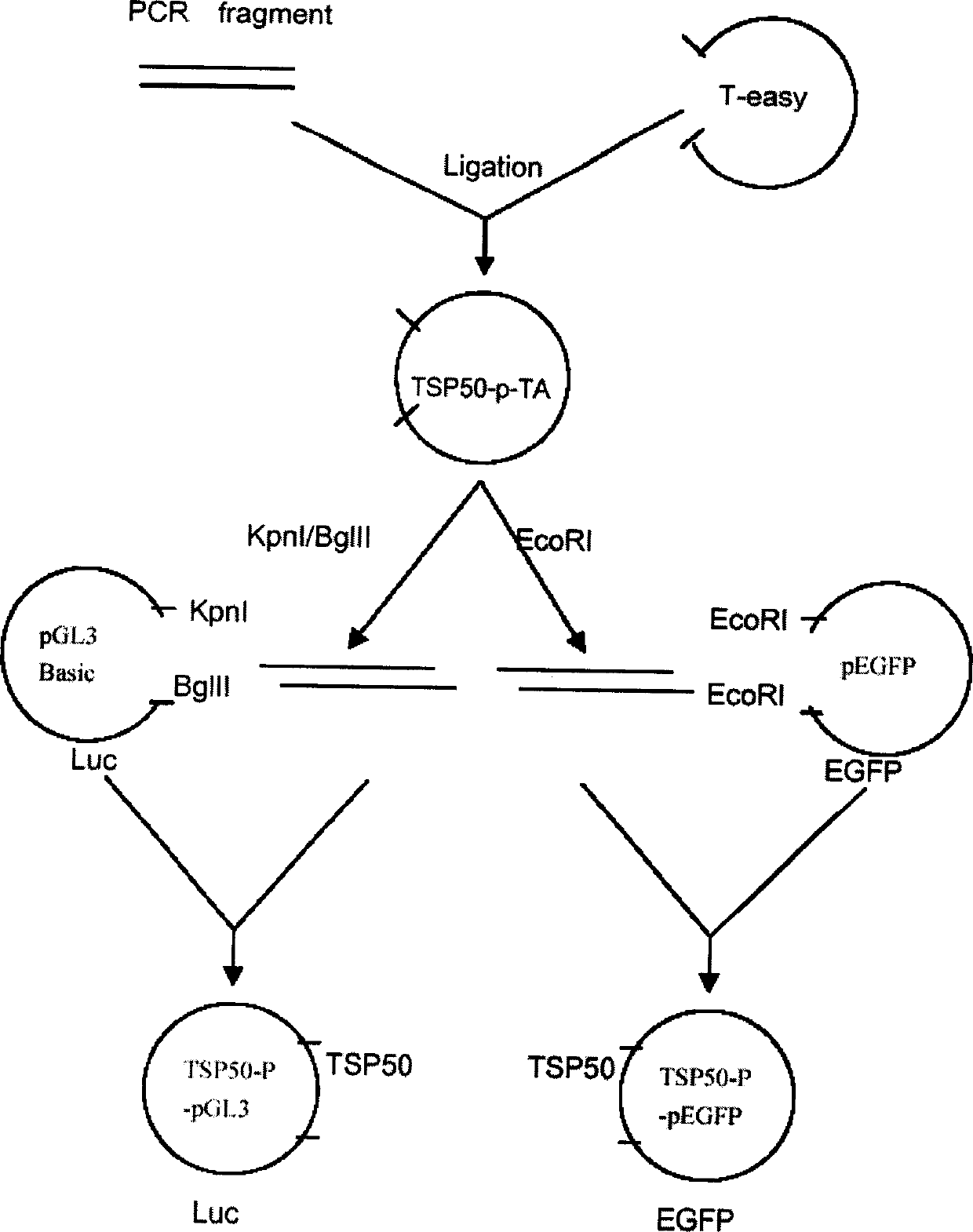Human testicle specificity protein 50 gene expression regulator screening system and method of screening its gene expression regulator
A technology of gene expression and regulator, applied in gene therapy, genetic engineering, plant genetic improvement, etc.
- Summary
- Abstract
- Description
- Claims
- Application Information
AI Technical Summary
Problems solved by technology
Method used
Image
Examples
Embodiment 1
[0052] Extraction of Human Genomic DNA
[0053] Take 3ml of heparin-anticoagulated human peripheral blood, centrifuge at 3000rpm at 4°C for 20 minutes, absorb the upper layer of plasma, add 5 times the volume of sterile double-distilled water, mix well, and place at room temperature for 5-10 minutes. 4000rpm, 4°C, centrifuge for 20 minutes, discard the supernatant. Add 5ml of normal saline to restore the white blood cells to an isotonic environment. Centrifuge at 4000rpm at 4°C for 15 minutes, discard the supernatant, and obtain the white blood cell layer. Add 5ml of digestion buffer (TES solution) (15mM Tris-cl, 15mM EDTA, 15mM Nacl, 0.5% SDS) to the white blood cells, add proteinase K to a final concentration of 0.1mg / ml, mix well, and place in a 50°C water bath for 3- 5 hours (4.5h). After cooling, add an equal volume of Tris phenol and extract twice with chloroform:isoamyl alcohol (24:1). Aspirate the supernatant carefully, add 1 / 10 volume of 3M sodium acetate (pH5.2),...
Embodiment 2
[0055] Fishing of the TSP50 promoter region
[0056] 1. Primer Design
[0057] Search the nucleotide sequence of the TSP50 promoter region from GenBank according to literature reports, and design primers for PCR amplification according to the sequence, so as to capture the TSP50 promoter. The primer sequences are as follows: the upstream primer is: 5'-GGGGTACCCCCAAGCAGTCC-3'; the downstream primer is: 5'-GAAGATCTTCCCGGGGTGGC-3'. The 5' end has a KpnI restriction site, and the 3' end has a BglII restriction site.
[0058] 2. PCR amplification, electrophoresis and recovery
[0059] Using human genomic DNA as a template, the primers synthesized above were used for PCR amplification. The PCR reaction conditions were: 94°C, 5min; 94°C, 1min, 62°C, 45sec, 72°C, 1min, 30 cycles; 72°C, 10min. The above PCR product was electrophoresed with 1% agarose gel and a 1.7Kb band was recovered.
[0060] 3. TA cloning and screening of PCR products
[0061] Ligate the above recovered produc...
Embodiment 3
[0063] Construction of TSP50-p-pGL3 and TSP50-p-pEGFP recombinant plasmids
[0064] Amplify the above-mentioned TA clone bacteria and extract the plasmid, digest with KpnI and BglII, and recover a 1.7Kb fragment; at the same time, digest pGL3 with KpnI and BglII, recover the digested plasmid, and combine the recovered fragment and pGL3 plasmid Use TAKARA ligase I for ligation. When constructing the TSP50-p-pEGFP recombinant plasmid, the positive TA cloning plasmid and the pEGFP vector were respectively digested with EcoRI and the fragments were recovered for ligation. The ligation method was carried out according to the instructions of the TAKARA Ligation Kit, at 16°C After 4 hours of ligation, the ligation product was treated as above and then electrotransformed into DH5α. The bacteria were spread on LB medium with ampicillin and cultured overnight in a 37°C incubator. Pick the colonies and inoculate them into 2ml of LB medium, shake and culture overnight at 37°C, extract the...
PUM
 Login to View More
Login to View More Abstract
Description
Claims
Application Information
 Login to View More
Login to View More - R&D
- Intellectual Property
- Life Sciences
- Materials
- Tech Scout
- Unparalleled Data Quality
- Higher Quality Content
- 60% Fewer Hallucinations
Browse by: Latest US Patents, China's latest patents, Technical Efficacy Thesaurus, Application Domain, Technology Topic, Popular Technical Reports.
© 2025 PatSnap. All rights reserved.Legal|Privacy policy|Modern Slavery Act Transparency Statement|Sitemap|About US| Contact US: help@patsnap.com



